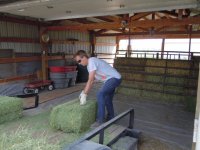I store enough hay to get me to the next harvest. To keep my storage area convertible I do it this way. It is dirt floor. I have an area that is twelve by forty eight that I use for storing. I put down four by four and four by six lumber on the ground such that use then as "sleepers". On top of them I lay plywood sheets and scraps to make a false floor. I salt the the wood before we start stacking the hay.
As the winter wears on, into spring, I pull up the sleepers and plywood that is exposed and use that area to supplement more lambing pens. Right now, we have hay stacked in only a 12 by 12 area. I use pressure treated,douglas fir, or western red cedar for sleepers. They rarely rot as long as I clean them up from mud and store them to air dry for the next year. It works out real well for me. Mice have a good time underneath, but I don't have any condensation problems with the bottom layer at all as long as I salt the plywood. I hate screwing around with plastic and tarps.
